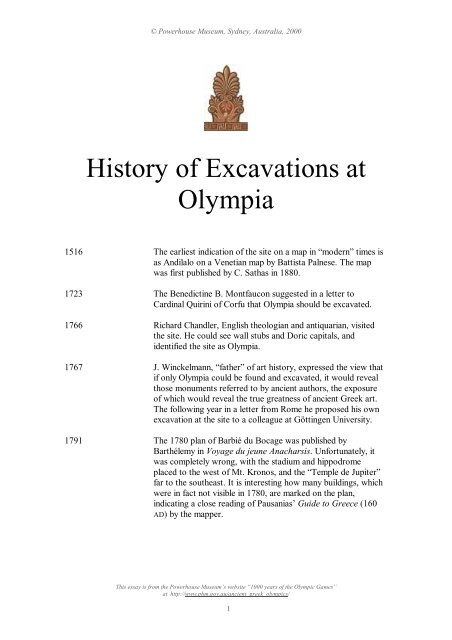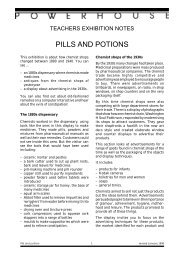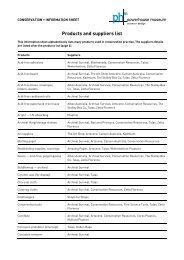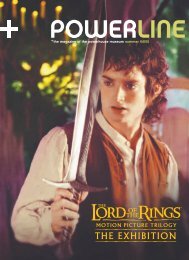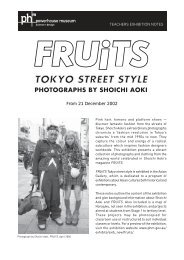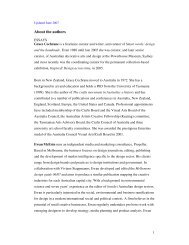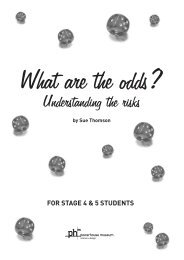History of Excavations at Olympia - Powerhouse Museum
History of Excavations at Olympia - Powerhouse Museum
History of Excavations at Olympia - Powerhouse Museum
Create successful ePaper yourself
Turn your PDF publications into a flip-book with our unique Google optimized e-Paper software.
© <strong>Powerhouse</strong> <strong>Museum</strong>, Sydney, Australia, 2000<br />
<strong>History</strong> <strong>of</strong> <strong>Excav<strong>at</strong>ions</strong> <strong>at</strong><br />
<strong>Olympia</strong><br />
1516 The earliest indic<strong>at</strong>ion <strong>of</strong> the site on a map in “modern” times is<br />
as Andilalo on a Venetian map by B<strong>at</strong>tista Palnese. The map<br />
was first published by C. S<strong>at</strong>has in 1880.<br />
1723 The Benedictine B. Montfaucon suggested in a letter to<br />
Cardinal Quirini <strong>of</strong> Corfu th<strong>at</strong> <strong>Olympia</strong> should be excav<strong>at</strong>ed.<br />
1766 Richard Chandler, English theologian and antiquarian, visited<br />
the site. He could see wall stubs and Doric capitals, and<br />
identified the site as <strong>Olympia</strong>.<br />
1767 J. Winckelmann, “f<strong>at</strong>her” <strong>of</strong> art history, expressed the view th<strong>at</strong><br />
if only <strong>Olympia</strong> could be found and excav<strong>at</strong>ed, it would reveal<br />
those monuments referred to by ancient authors, the exposure<br />
<strong>of</strong> which would reveal the true gre<strong>at</strong>ness <strong>of</strong> ancient Greek art.<br />
ThefollowingyearinaletterfromRomeheproposedhisown<br />
excav<strong>at</strong>ion <strong>at</strong> the site to a colleague <strong>at</strong> Göttingen University.<br />
1791 The 1780 plan <strong>of</strong> Barbié du Bocage was published by<br />
Barthélemy in Voyage du jeune Anacharsis. Unfortun<strong>at</strong>ely, it<br />
was completely wrong, with the stadium and hippodrome<br />
placed to the west <strong>of</strong> Mt. Kronos, and the “Temple de Jupiter”<br />
far to the southeast. It is interesting how many buildings, which<br />
were in fact not visible in 1780, are marked on the plan,<br />
indic<strong>at</strong>ing a close reading <strong>of</strong> Pausanias’ Guide to Greece (160<br />
AD) by the mapper.<br />
This essay is from the <strong>Powerhouse</strong> <strong>Museum</strong>’s website “1000 years <strong>of</strong> the Olympic Games”<br />
<strong>at</strong> http://www.phm.gov.au/ancient_greek_olympics/<br />
1
© <strong>Powerhouse</strong> <strong>Museum</strong>, Sydney, Australia, 2000<br />
1806 The Englishmen Edward Dodwell and William Gell, assisted<br />
by local labourers, exposed part <strong>of</strong> the Temple <strong>of</strong> Zeus. They<br />
revealed column drums lying in a row and part <strong>of</strong> the black<br />
floor mentioned by Pausanias in his Guide to Greece, written<br />
around 160 AD.<br />
1807 Wilkins published The Antiquities <strong>of</strong> Magna Graecia, inwhich<br />
he included a plan based on the work <strong>of</strong> Dodwell and Gell. He<br />
identified the Temple as a 6 x 13 peripteral temple.<br />
1813 Lord Spencer Stanhope and his architect Allason made a<br />
measured plan <strong>of</strong> <strong>Olympia</strong>.<br />
1830 Lt. Leake published Travels in Morea, based on his journeys in<br />
1805. He included Stanhope and Allason’s plan <strong>of</strong> <strong>Olympia</strong>.<br />
10 May 1829 Excav<strong>at</strong>ion work began under Dubois and A. Blouet <strong>of</strong> the<br />
Louvre by the French team <strong>of</strong> soldiers and scientists <strong>of</strong> the<br />
Expédition scientifique de Morée. This team had come<br />
immedi<strong>at</strong>ely after Greece had won independence from the<br />
Ottoman Empire.<br />
Work concentr<strong>at</strong>ed on the Temple <strong>of</strong> Zeus. Some fragments <strong>of</strong><br />
the metopes were found (which are now in the Louvre in Paris).<br />
Attempts were made to find the pedimental sculpture, but after<br />
realising th<strong>at</strong> the ancient ground surface lay some five metres<br />
below the current ground level, east <strong>of</strong> the Temple <strong>of</strong> Zeus,<br />
work there was abandoned.<br />
The Triton mosaic in the pronaos (front porch) was exposed, as<br />
well as two more columns and more black flooring in the<br />
interior <strong>of</strong> the Temple.<br />
Leaving the Temple, the team moved to a substantial building<br />
further west. This was the Byzantine church, which was<br />
subsequently shown to have been built in the ruins <strong>of</strong> Pheidias’<br />
workshop.<br />
No further excav<strong>at</strong>ion was permitted, although the fragments <strong>of</strong><br />
metopes and other sculptures were removed to the Louvre.<br />
The French published promptly in three volumes.<br />
1834 L. Roß was appointed the Chief Conserv<strong>at</strong>or <strong>of</strong> Antiquities in<br />
Greece by King Otto.<br />
This essay is from the <strong>Powerhouse</strong> <strong>Museum</strong>’s website “1000 years <strong>of</strong> the Olympic Games”<br />
<strong>at</strong> http://www.phm.gov.au/ancient_greek_olympics/<br />
2
© <strong>Powerhouse</strong> <strong>Museum</strong>, Sydney, Australia, 2000<br />
The Temple <strong>of</strong> Zeus <strong>at</strong> <strong>Olympia</strong>, part <strong>of</strong> one <strong>of</strong> the detailed plans in<br />
<strong>Olympia</strong> I, folio volume, pl<strong>at</strong>e VIe<br />
With permission Verlag Adolf M. Hakkert, Amsterdam<br />
1875-1881 The Imperial German Archaeological Institute, which had<br />
opened <strong>of</strong>fices in Athens, began work <strong>at</strong> <strong>Olympia</strong> with the<br />
support and permission <strong>of</strong> the Greek authorities.<br />
The work was carried out under the authority <strong>of</strong> a special<br />
contract, which had been r<strong>at</strong>ified by the Greek parliament. This<br />
was the first contract <strong>of</strong> its kind ever issued for an<br />
archaeological project.<br />
Heinrich Schliemann, famous excav<strong>at</strong>or <strong>of</strong> Troy and Mycenae,<br />
had applied for a licence to excav<strong>at</strong>e <strong>Olympia</strong> <strong>at</strong> the same time,<br />
and was disappointed to have missed out.<br />
The first project, which ran until 1881 included as directors E.<br />
Curtius, W. Dörpfeld, G. Hirschfeld, A. Furtwängler and G.<br />
Treu. These men were some <strong>of</strong> the leaders <strong>of</strong> Classical<br />
Archaeology <strong>of</strong> their time, and scholars <strong>of</strong> the highest<br />
standards. Curtius in particular had been working since 1836 to<br />
obtain backing and permission for just such a project.<br />
Public<strong>at</strong>ion was prompt with hundreds <strong>of</strong> detailed plans,<br />
elev<strong>at</strong>ions, sections, object drawings and reconstructions.<br />
A museum was opened <strong>at</strong> the site, where most <strong>of</strong> the over<br />
14,000 objects inventoried were displayed or stored. The Greek<br />
benefactor Andreas Syngros provided the funding for the<br />
building which was constructed between 1886 and 1888,<br />
designed after ancient Greek structures.<br />
1908-1929 Under Dörpfeld, work resumed, and for the first time evidence<br />
<strong>of</strong> the earliest periods <strong>at</strong> <strong>Olympia</strong> was extensively investig<strong>at</strong>ed.<br />
This essay is from the <strong>Powerhouse</strong> <strong>Museum</strong>’s website “1000 years <strong>of</strong> the Olympic Games”<br />
<strong>at</strong> http://www.phm.gov.au/ancient_greek_olympics/<br />
3
© <strong>Powerhouse</strong> <strong>Museum</strong>, Sydney, Australia, 2000<br />
1936-1943 Spurred by the Berlin Olympics in 1936, a new series <strong>of</strong> limited<br />
excav<strong>at</strong>ions were directed by E. Kunze and H. Schleif.<br />
1952-1966 E. Kunze and A. Mallwitz directed seasons which were<br />
particularly fruitful in establishing the chronology <strong>of</strong> the site in<br />
the fifth and fourth centuries BC. After 25 years work the<br />
stadium was fully excav<strong>at</strong>ed in 1962.<br />
1969 Stephen Miller made a detailed investig<strong>at</strong>ion <strong>of</strong> the prytaneion<br />
(Council House), as Dörpfeld’s work was unclear for the<br />
interpret<strong>at</strong>ion <strong>of</strong> this very important building. Unfortun<strong>at</strong>ely,<br />
Miller was unable to elucid<strong>at</strong>e the exact history <strong>of</strong> the building,<br />
but made corrections to Dörpfeld’s work.<br />
1972 – present <strong>Olympia</strong> is under the authority <strong>of</strong> the 7 th Ephor<strong>at</strong>e <strong>of</strong> Prehistoric<br />
and Classical Antiquities, based <strong>at</strong> the <strong>Museum</strong> <strong>at</strong> Ancient<br />
<strong>Olympia</strong>, and which undertakes its own research programme <strong>at</strong><br />
the site.<br />
A new museum was opened <strong>at</strong> Ancient <strong>Olympia</strong> in 1982, nearly<br />
100 years after the first. This allowed, amongst many other<br />
improvements, a new arrangement <strong>of</strong> the pedimental and<br />
metope sculptures from the Temple <strong>of</strong> Zeus. The Nike <strong>of</strong><br />
Paionios is also now displayed in a wonderful setting.<br />
The German Archaeological Institute (DAI), in collabor<strong>at</strong>ion<br />
with the Hellenic Ministry <strong>of</strong> Culture, continues to sponsor<br />
projects <strong>at</strong> <strong>Olympia</strong>.<br />
Although limited excav<strong>at</strong>ions do continue, restor<strong>at</strong>ion work is<br />
now taking a higher priority.<br />
The DAI carried out further work on the prytaneion (1993-<br />
1996), but were unable to solve the problems.<br />
Specific issues, such as the retaining wall <strong>of</strong> the Kladeos are the<br />
subject <strong>of</strong> continuing excav<strong>at</strong>ions.<br />
A major research project dealing with the l<strong>at</strong>er history <strong>of</strong><br />
<strong>Olympia</strong> has begun, investig<strong>at</strong>ing the Roman and Byzantine<br />
periods <strong>at</strong> the site.<br />
Research work continues on the objects already excav<strong>at</strong>ed.<br />
Public<strong>at</strong>ion <strong>of</strong> special research topics is undertaken through a<br />
substantial monograph series.<br />
This essay is from the <strong>Powerhouse</strong> <strong>Museum</strong>’s website “1000 years <strong>of</strong> the Olympic Games”<br />
<strong>at</strong> http://www.phm.gov.au/ancient_greek_olympics/<br />
4
Bibliography<br />
Older works:<br />
© <strong>Powerhouse</strong> <strong>Museum</strong>, Sydney, Australia, 2000<br />
R. Chandler Travels in Greece or an Account <strong>of</strong> the Society <strong>of</strong> Dilettanti,<br />
1766<br />
J.-J. Barthélemy Voyage du jeune Anacharsis en Grèce dans le milieu du<br />
qu<strong>at</strong>rième siècle avant l’ère vulgaire, 1791<br />
J. Spencer Stanhope <strong>Olympia</strong> or Topography Illustr<strong>at</strong>ive <strong>of</strong> the Actual St<strong>at</strong>e <strong>of</strong> the<br />
Plain <strong>of</strong> <strong>Olympia</strong> and <strong>of</strong> the Ruins <strong>of</strong> the City <strong>of</strong> Elis, 1824<br />
J. J. Winckelmann Anmerkungen über die Geschichte der Kunst des Altertums,<br />
1767<br />
A. Blouet Expédition scientifique de Morée, 1831-1838<br />
C. A. S<strong>at</strong>has Documents inédits rel<strong>at</strong>ifs à l’histoire de la Grèce au moyen<br />
âge, 1880, Paris<br />
Modern excav<strong>at</strong>ions:<br />
A. Boetticher <strong>Olympia</strong>, das Fest und seine Staette, 1886, Verlag von Julius<br />
Springer, Berlin,<br />
<strong>Olympia</strong>. Die Ergebnisse der vom Deutschen Reich veranstalteten Ausgrabung,<br />
volumes I-V:<br />
F.Adler,E.Curtius,W.Dörpfeld,P.Graef,J.Partsch&R.Weil<br />
<strong>Olympia</strong> I: Topographie und Geschichte, 1897/1966, (reprint<br />
publisher: Verlag Adolf M. Hakkert), Amsterdam<br />
F. Adler, R. Borrmann, W. Dörpfeld, F. Graeber & P. Graef<br />
<strong>Olympia</strong> II: Die Baudenkmäler von <strong>Olympia</strong>, 1892/1966,<br />
(reprint publisher: Verlag Adolf M. Hakkert), Amsterdam<br />
G. Treu <strong>Olympia</strong> III: Die Bildwerke von <strong>Olympia</strong> in Stein und Ton,<br />
1897/1966, (reprint publisher: Verlag Adolf M. Hakkert),<br />
Amsterdam<br />
A. Furtwängler <strong>Olympia</strong> IV: Die Bronzen und die übrigen kleineren Funde von<br />
<strong>Olympia</strong>, 1897/1966, (reprint publisher: Verlag Adolf M.<br />
Hakkert), Amsterdam<br />
W. Dittenberger & K. Purgold<br />
<strong>Olympia</strong> V: Die Inschriften von <strong>Olympia</strong>, 1896/1966, (reprint<br />
publisher: Verlag Adolf M. Hakkert), Amsterdam<br />
This essay is from the <strong>Powerhouse</strong> <strong>Museum</strong>’s website “1000 years <strong>of</strong> the Olympic Games”<br />
<strong>at</strong> http://www.phm.gov.au/ancient_greek_olympics/<br />
5
© <strong>Powerhouse</strong> <strong>Museum</strong>, Sydney, Australia, 2000<br />
Various authors Berichte über die Ausgrabungen in <strong>Olympia</strong> (volumes I – X),<br />
1937 – 1994 (Volume XI in prepar<strong>at</strong>ion)<br />
Various authors Olympische Forschungen (monograph series), (volumes 1 –27),<br />
1944-1998 (and continuing)<br />
S. G. Miller “The Prytanaeion <strong>at</strong> <strong>Olympia</strong>”, Athenische Mitteilungen DAI,<br />
86, 1971, 79-107<br />
A. & N. Yalouris <strong>Olympia</strong>: Guide to the <strong>Museum</strong> and the Sanctuary, 1998,<br />
Ekdotike Athenon S. A<br />
Many other reports can be found in a range <strong>of</strong> scholarly journals, particularly Greek and<br />
German public<strong>at</strong>ions.<br />
Images:<br />
Palmette Terracotta akroterion from the workshop <strong>of</strong> Pheidias <strong>at</strong><br />
<strong>Olympia</strong>, made around 430 BC,<br />
from <strong>Olympia</strong> II: Die Baudenkmäler von <strong>Olympia</strong>, F. Adler et.<br />
al.<br />
Pl<strong>at</strong>e CCXXII no. 3<br />
used with permission from Verlag Adolf M. Hakkert<br />
Temple <strong>of</strong> Zeus <strong>at</strong> <strong>Olympia</strong> plan<br />
from <strong>Olympia</strong> I: Topographie und Geschichte, F.Adleret.al.,<br />
Map VIe<br />
used with permission from Verlag Adolf M. Hakkert<br />
This essay is from the <strong>Powerhouse</strong> <strong>Museum</strong>’s website “1000 years <strong>of</strong> the Olympic Games”<br />
<strong>at</strong> http://www.phm.gov.au/ancient_greek_olympics/<br />
6


